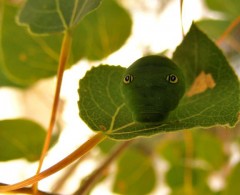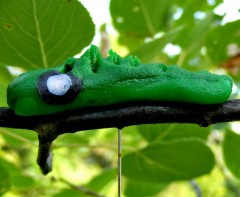On some days, PhD candidate Thomas Hossie spends his time at Carleton making model caterpillars out of coloured pastry that could be mistaken for Play Doh™. His blog, Caterpillar Eyespots, is plastered with pictures and video footage of the squirmy creatures. If you visit it, you’ll be rewarded with an enthralling look into the world of caterpillars and butterflies, a world of playful fascination for Hossie.
Considering that all of that dough may one day help us understand the ecology and evolution of caterpillars, it’s no wonder he is attracting international attention for his research. Hossie uses the dough to create hundreds of caterpillar models, most of which are placed on trees in the wild to be pecked at by birds and other predators. The goal is to discover why some types of caterpillars have evolved conspicuous eyespots, despite not actually using them to see. It is the first major body of research that attempts to examine the protective effects of the spots.
 Caterpillars with eyespots are generally thought to be snake-mimics. The strategy, according to the general hypothesis, aims to protect the caterpillar from birds and other predators. It’s an idea that has yet to be demonstrated and fully understood.
Caterpillars with eyespots are generally thought to be snake-mimics. The strategy, according to the general hypothesis, aims to protect the caterpillar from birds and other predators. It’s an idea that has yet to be demonstrated and fully understood.
“This project indicated that eyespots alone may not be sufficient to deter birds from attacking,” said Hossie. “However our experimental design did not include caterpillar behaviour, which may play a critical role in deterring bird attacks.”
On the lighter side, Hossie is interested in all aspects of the caterpillar world, even pop culture. In one particularly illuminating blog post, he explores the fictional creatures of the animated Pokémon series to discover that many of them are based on real-life caterpillars.
“I have always thought the little downward-slanting markings within the eyespots of some Papilio caterpillars looked like the classic cartoon eyebrows used to indicate a character’s anger,” writes Hossie. “In fact, a similar technique has been used with (Pokémon character) Caterpie when the character is launching its String Shot attack.”
 Despite the light-hearted nature of the piece, the blog could be an enlightening resource for those aspiring to delve into caterpillar and butterfly fieldwork. Hossie discusses catching and mating techniques, families and species, behaviours and more as he recounts his own experiences in locales as exotic as Costa Rica.
Despite the light-hearted nature of the piece, the blog could be an enlightening resource for those aspiring to delve into caterpillar and butterfly fieldwork. Hossie discusses catching and mating techniques, families and species, behaviours and more as he recounts his own experiences in locales as exotic as Costa Rica.
Hossie is already casting his eye toward the next steps of his research.
“The next logical step is to determine how well these live caterpillars, using their behaviour, can deter attacking birds,” he said.
The results of Hossie’s research can be read here, and will be published in the August issue of the journal Animal Behaviour.
-30-
For more information:
Chris Cline
Media Relations
Carleton University
613-520-2600, ext. 1391
christopher_cline@carleton.ca
Follow us on Twitter: twitter.com/CUnewsroom